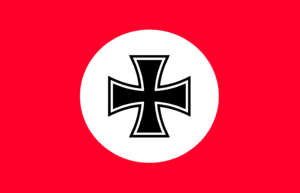Germania: Difference between revisions
No edit summary |
No edit summary |
||
| Line 49: | Line 49: | ||
<div class="element flag">'''Paramilitary Wings:''' | <div class="element flag">'''Paramilitary Wings:''' | ||
[[File: | [[File:Schutzstaffel Flag.png|40px]] [[Schutzstaffel]] | ||
[[File: | [[File:SS-Begleitkommando Des Führers Flag.png|40px]] [[SS-Begleitkommando des Führers]] | ||
[[Dublin Razor Gang]]</div> | [[Dublin Razor Gang]]</div> | ||
Revision as of 23:37, 26 April 2024

Jack Nelson (former, temporary)
Gustavo Salamanca (former)
Wilhelm Goertzmann (former)
Heinrich Himmler (former)
Martin Heusmann (former, temporary)
Hermann Göring (former)
Walter Murphy (former, temporary)
Adolf Hitler (former)Germania is a nation in the Man in the High Brick.
History
The history of Germania stays the same until 1933 of our timeline. After this period, Adolf Hitler gains full control of the German Reich with his party, the NSDAP. Hitler adapts a less Nazist ideology. Hitler converts the German Reich to a more militaristic state, but without the sense of racial purity. Hitler quickly rises to power in Europe using the newly installed Wehrmacht. Together with the Blitzkrieg techniques, the Wehrmacht invades countries relatively fast.
In 1937, the Anschluss takes place. Austria is annexed. Austrian leaders that supported Adolf Hitler before the Anschluss received extra high ranking positions. An example is Arthur Seyss-Inquart, who received the rank of Reichskommissar.
Hitler would continue his conquest of Europe. Czechoslovakia was Hitlers next target. The Wehrmacht quickly defeated Czechoslovakia, and then prepared to invade Poland. At this moment, the Soviet Union threatened to invade Poland as well. The Obergruppenführer, Joachim von Ribbentrop, met with the Soviet politician and diplomat, Vjatsjeslav Molotov. Both leaders agreed to a non-aggression pact between the German Reich and the Soviet Union. Following this, Hitler ordered the Wehrmacht to invade parts of Poland. This was followed up by a Soviet Invasion into Poland. After 35 days Poland capitulated. Hitler scrapped his earlier plans for Lebensraum. He instead wanted to focus on Germany itself, and therefore keeping peace with the Soviet Union, unlike in our timeline.
Hitler, together with a few other high ranking German officials met up in a military headquarters, located in Prussia, the Wolf's Lair. Among these high ranking German officials, was Heinrich Himmler and Joseph Goebbels. An assassination was attempted on the lives of Adolf Hitler, Heinrich Himmler, Joseph Goebbels, and a few other generals. This plot was called Operation Valkyrie. A table these leaders would talk at was exploded, injuring Hitler as well as Killing Goebbels and a few high ranking generals. Heinrich Himmler survived, as well as some other high ranking officials. Soon after the explosion, Claus von Stauffenberg was arrested by SS units, ordered by Himmler. Claus von Stauffenberg claimed he was alone in this conspiracy, to take Hitler down. A few other officers were arrested as well and sentenced to life in prison for the time being. Claus von Stauffenberg, on his way to the prison, was assassinated by a sniper, likely being a member of this plot.
Immediately after Hitlers death, though not being the first choice to likely overtake Hitlers position as Führer, Reichsmarschall at the time, Hermann Göring, assumed control of the Reich. Himmler was the first in line to become Führer but he was injured and in the hospital. Hermann Göring took the rank of Stellvertretender Kanzler on himself and kept Himmler as Reichsführer. Due to Hitler's high chance of passing away due to his injuries, Joseph Goebbels's recent death and Himmler's presence in the hospital due to his injuries, Göring appointed himself as Führer. He threatened to have Himmler arrested if he protested. Göring then would attempt to locate more conspirators aiding Claus von Stauffenberg. Ultimately he had arrested one more person, Helmfriend Wehner, who likely died in prison. Göring halted the investigations and ceased them a while later, due to there being no evidence there were more members.
Hermann Göring would lead a relatively calm Germania after this incident. Eventually, Hermann Göring would become ill. It had become clear he had been poisoned. Though it was likely he was poisoned by a high ranking Germanic official, it was unclear what caused it. Reichsminister Martin Heusmann jumped to the conclusion it was by Japanese assassins, attempted to kill the Führer. Göring ordered Amon Goeth to rise to power as temporary chancellor. However, Goeth did not become this. Instead, Martin Heusmann took the rank of Stellvertretender Kanzler. He aimed for a war against the Empire of Japan. The Kriegsführer, Rudolf Riefenstein, devised a plan to invade the Empire of Japan. He was ordered to do so by Heusmann. In the meantime, Oberstgruppenführer John Smith interrogated and misinformed a member of Heusmann’s Conspiracy, Oberstgruppenführer Reinhard Heydrich, who had tried to assassinate John Smith. Reinhard Heydrich revealed Heusmann was the ringleader of the conspiracy. John Smith went to Heinrich Himmler and informed him about Heusmann's treason. Heusmann was then arrested and investigations to locate any other members of the conspiracy commenced.